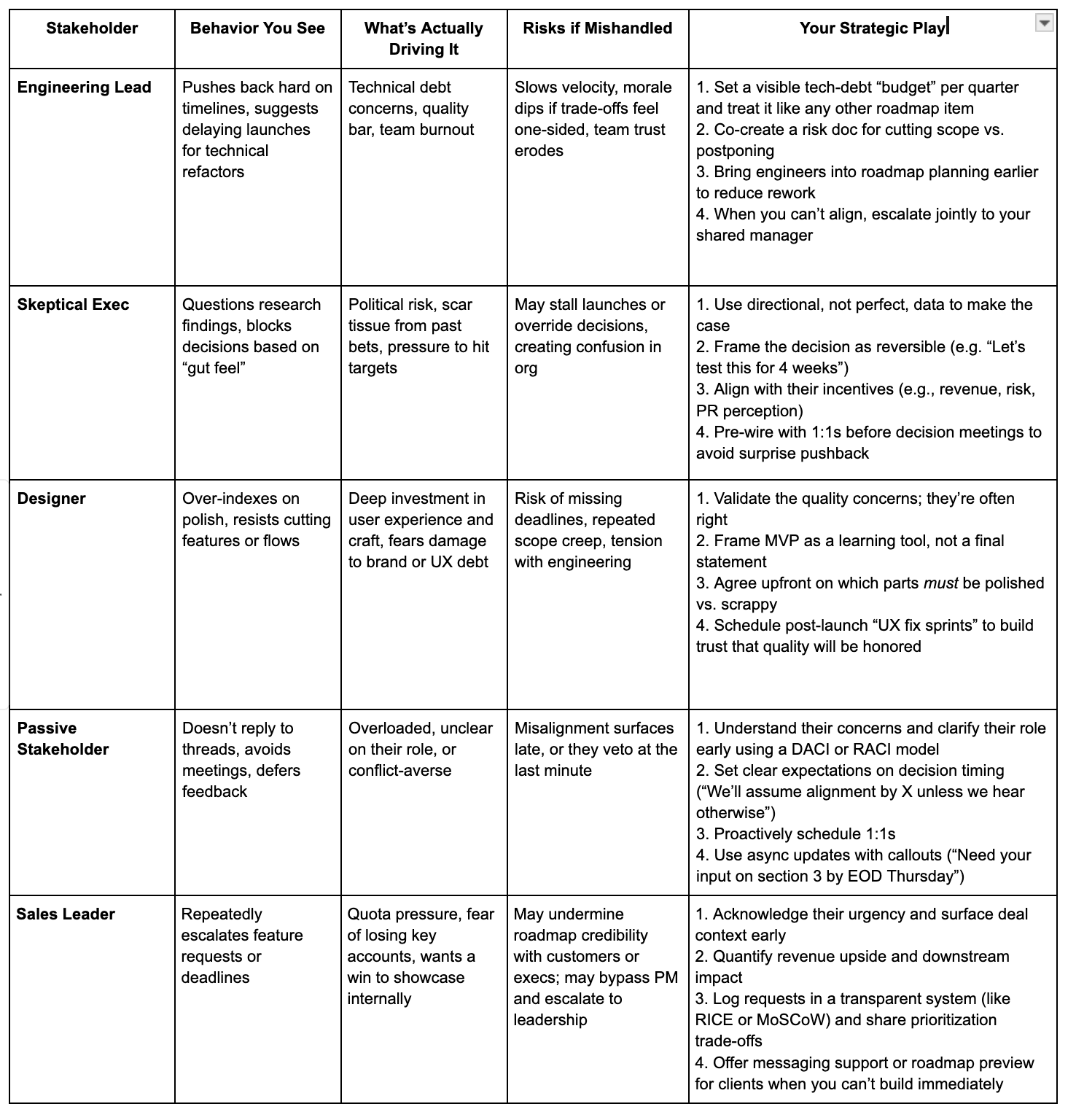Part 3: Decoding Stakeholders and Building Emotional Intelligence
In product management, conflict rarely happens in a vacuum. It’s not just about the feature, the timeline, or the metric. It’s about who’s asking, why, and what’s at stake for them. Stakeholder dynamics, often invisible, are one of the most persistent sources of friction on any product team.
The good news is that when you understand the motivations behind the tension, you can respond strategically instead of reactively.
Stakeholder Archetypes and Tailored Plays
Every function you work with—Sales, Engineering, Design, Leadership—comes with its own incentives, constraints, and mental models. That means a one-size-fits-all approach to conflict simply won’t work.
Great PMs don’t just adjust what they say. They adapt how they engage.
Here are five common stakeholder archetypes, the patterns they exhibit, and the moves that can turn friction into forward motion:
These plays aren’t manipulative—they’re empathetic. By meeting stakeholders where they are, you build trust and influence that scales.
Foundational Conflict Habits and EQ: What Sets Great PMs Apart
Tactics only go so far if your core behaviors are reactive or defensive. What separates strong product managers from great ones is how they behave when stakes are high and emotions run hot.
Foundational Habits
Stay calm even when others don’t
Losing your temper might win the argument, but it rarely wins the war. Calm PMs unlock calmer teams.De-escalate, don’t escalate
When tempers flare, your job is to return focus to the problem—not the personalities. Normalize disagreement. Keep your tone even. Step away from Slack if needed.Validate before explaining
Don’t rush to logic. First, make them feel heard:Let them vent.
Mirror their concern.
Acknowledge the impact and then share your constraints.
EQ in Action
Hold 1:1s that aren’t status updates.
Ask: “What’s bothering you that no one’s said out loud?” You’ll surface buried tension before it explodes.Debrief team trust, not just launches.
After a tough sprint, ask how the team felt. This builds long-term psychological safety.
Strategic Escalation: What I Learned About Moving Fast
Early in my career, I thought escalation meant failure and that if I were good enough at managing relationships, I’d never need it.
I was wrong.
Escalation, when done thoughtfully, is one of the fastest ways to unblock a team. The key is to use it not as a weapon, but as a lever for clarity, speed, and focus.
Now, I escalate when:
I’ve tried all the approaches outlined in Parts 1, 2, and 3, but we’re still stuck
The issue is slowing down something high-impact
There’s a misalignment that only leadership can resolve
The team’s energy is getting drained by friction
When I escalate, I keep it centered on shared goals: What are we trying to achieve? What tradeoffs need to be made? What’s the fastest way forward?
Done right, it’s not about blame. It’s about momentum. And great PMs know when it’s time to ask for help so the team can keep building.
The most effective product teams don’t avoid conflict. They embrace it and transform it into better ideas, stronger alignment, and faster progress.
When the temperature rises again (and it will), don’t retreat. Lean in with clarity, empathy, and a toolkit that helps the whole team come out stronger on the other side.



